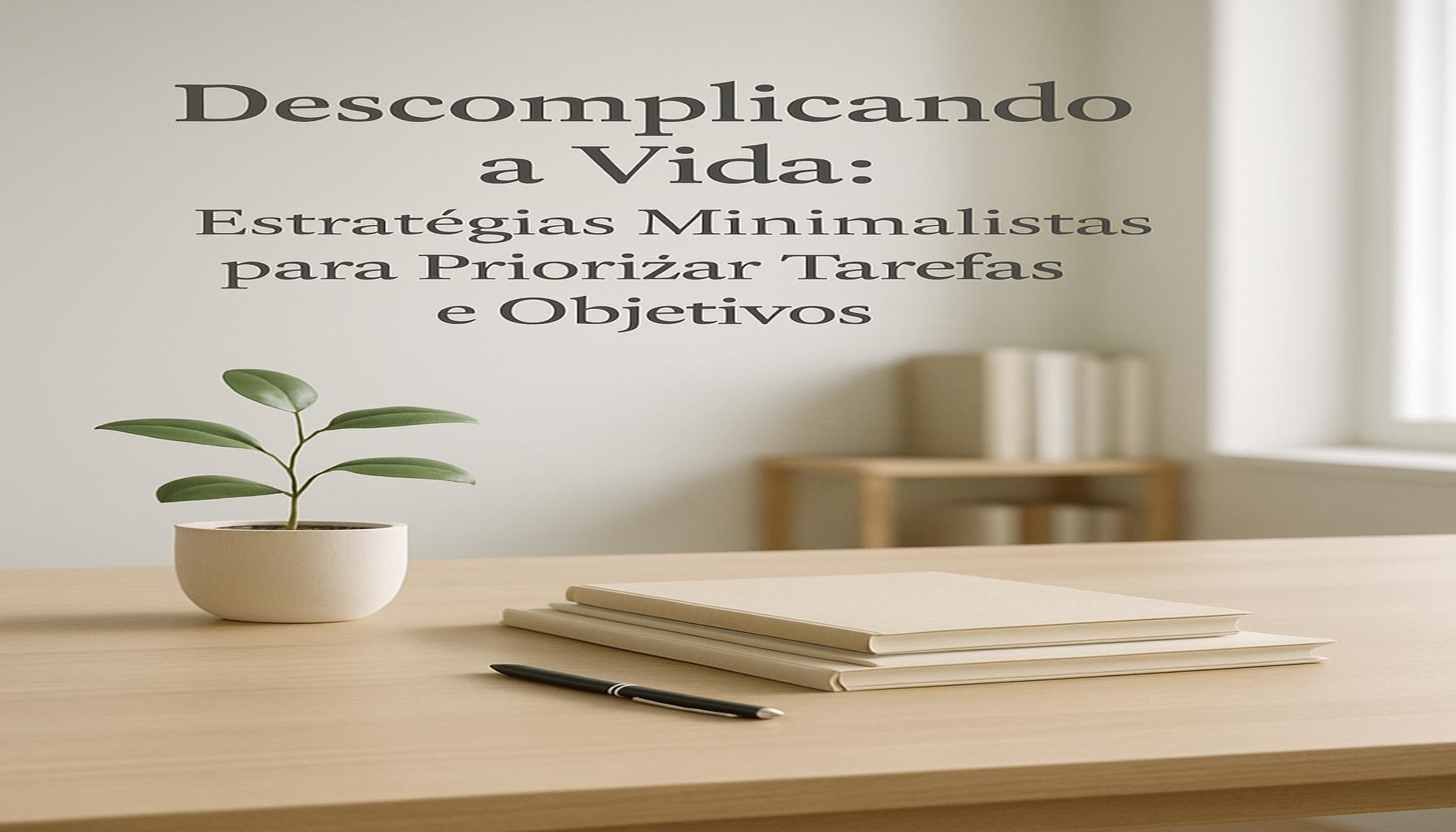Simplify Life Minimalist Strategies for Prioritizing Tasks Goals

Embracing Minimalism in a Busy World
In today’s fast-paced society, the pressure to juggle numerous responsibilities and ambitions can feel overwhelming. The concept of minimalism offers a refreshing alternative, urging us to strip away the unnecessary clutter in our lives—both physical and mental. This approach not only enhances our well-being but also empowers us to focus on what truly matters.
As people increasingly seek ways to enhance their productivity and mental clarity, prioritizing tasks and defining clear objectives have never been more relevant. Minimalism invites us to evaluate our commitments, ensuring each task aligns with our core values and long-term goals. By simplifying our approach, we can redirect our energies toward meaningful achievements.
In this article, we will explore practical strategies that embody this minimalist philosophy. Prepare to discover the Top 5 techniques designed to help you prioritize effectively and reclaim control over your life. Through these insights, you will learn to embrace the essence of minimalism, leading to not only a more organized lifestyle but also a more focused and fulfilling existence.
Descomplicando a Vida: Estratégias Minimalistas para Priorizar Tarefas e Objetivos
In today’s frantic pace of life, characterized by constant notifications, ceaseless information flow, and incessant multitasking, the capacity to prioritize effectively has transformed into a pivotal skill. Overwhelmed by the myriad of choices and tasks daily, many individuals find themselves in a state of persistent stress. Amidst this chaos, minimalism emerges as a beacon of clarity. It advocates for reducing complexity, encouraging focus on what truly delivers value. Let’s explore five strategies that leverage minimalism to streamline tasks and goals, fostering a more gratifying and productive existence.
5. Embrace “Less is More”
The mantra of “less is more” forms the core of minimalism. This philosophy urges a thoughtful examination of our surroundings and lifestyle. By stripping away the non-essential in our physical and mental environments, we pave the way for enhanced focus and tranquility. Consider the following reflective questions:

- What can I let go of that no longer serves my goals? This question invites an audit of one’s current engagements, encouraging the release of tasks and responsibilities that no longer add value.
- Are there tasks I can delegate or eliminate altogether? Identifying non-essential duties that can be transferred to others or completely removed from your plate can drastically decrease stress.
- What values do I genuinely want to focus on? By clarifying your core values, you ensure your actions align closely with what’s important, enhancing overall fulfillment.
This introspection, although initially daunting, enables a life concentrated on select, high-value activities, leading to deeper satisfaction and increased productivity. Studies have shown that cluttered environments can lead to decreased focus and elevated stress levels, suggesting that physical decluttering could also contribute to mental clarity.
4. The Eisenhower Matrix: Distinguishing Urgent from Important
Introduced by former U.S. President Dwight D. Eisenhower, the Eisenhower Matrix is a quintessential tool in task prioritization. It allows us to differentiate between what yearns for immediate attention and what merits long-term importance. Here’s a breakdown of this innovative framework:
- Quadrant 1: Tasks both urgent and important – they require prompt attention. Examples include pressing deadlines or crises.
- Quadrant 2: Tasks important but not urgent – these are the pinnacles of personal and professional growth, like planning, relationship building, and strategizing.
- Quadrant 3: Tasks urgent but not important – oftentimes, these can be delegated. Routine work emails often fall into this category.
- Quadrant 4: Tasks neither urgent nor important – these are typically time-wasters and should be discarded. Frequent social media browsing without purpose typifies this quadrant.
The matrix’s brilliance lies in its simplicity, promoting a discerning approach that cuts through the clutter. By conscientiously categorizing tasks, one’s to-do list evolves from an overwhelming barrage to an empowered action plan focused on significant goals.
3. Set Clear Intentions and Goals
To navigate life’s complexities, goals act as guiding stars. However, not all aspirations are created equal. Establishing clear intentions transforms aspirations into actionable objectives. The SMART criteria serve as a robust framework:
- Specific: A clearly defined goal leaves no space for ambiguity. “I want to write a book” becomes more actionable with specifics: “I will write a 60,000-word novel.”
- Measurable: Measurement provides motivation: “Complete 1,000 words a day” introduces tangible progress markers.
- Achievable: Realistic goals prevent demotivation. Assess your resources and limitations – can the time and effort required be justified?
- Relevant: Ensure goals align with your overarching life mission. Writing aligns both with professional dreams of authoring and personal passions.
- Time-bound: Deadlines avoid procrastination. “Finish draft within six months” imbues urgency and structure.
Employing the SMART framework fosters accountability and facilitates precision, guiding one toward significant results while mitigating the chaos of vague aspirations.
2. Practice Mindfulness in Daily Tasks
Mindfulness represents a potent ally in the quest for simplification and focus. Embedding it in daily tasks cultivates a heightened sense of presence, reinforcing concentration and joy in simplicity. Embrace these mindfulness techniques:
- Single-tasking: Contrary to the myth of multitasking efficacy, neuroscientific research advocates single-tasking for superior performance. Devote your attention to one task at a time.
- Take brief breaks: Short, regular intervals refresh the mind and stave off cognitive overload.
- Set daily intentions: Beginning each day with a clarified focal point enhances direction and diminishes distractions.
Mindfulness acts as a counterweight to disorder, facilitating calmer, more intentional decision-making and task execution, ultimately resulting in reduced stress and enhanced productivity.
1. Adopt the “One Thing” Principle
Standing atop the minimalist strategies, the “One Thing” principle, articulated vividly by Gary Keller, underscores the power of singular focus. Its essence lies in pinpointing the day’s most crucial task—the one yielding the maximum impact—and prioritizing it above all else. Steps to embrace this principle include:
- Reflect on your long-term goals: Understand the broader picture before zeroing in on a specific task.
- Identify daily tasks aligning with your priority: Choose tasks that directly contribute to your overarching aims.
- Commit unwaveringly: Begin your day by tackling this task, refusing to shift until completion.
By adopting the “One Thing” principle, day-to-day tasks transform into stepping stones toward significant achievements. It cultivates a focused and intentional lifestyle, ensuring actions resonate with profound purpose.
Adopting these minimalist strategies not only disentangles the intricate web of modern life but also enriches the pursuit of objectives. In the relentless march toward productivity, embracing minimalism as a guiding ethos offers clarity, depth, and satisfaction, rekindling a seamless alignment between doing and being.
| Category | Key Features | Advantages | Disadvantages | Who Would Benefit |
|---|---|---|---|---|
| Time Management | Utilizing tools and techniques to allocate your time efficiently. | Enhanced productivity by focusing on high-priority tasks and reducing wasted time. | May not suit everyone, as some prefer a more flexible approach. | Those struggling with procrastination or who manage multiple projects. |
| Decluttering | Removing unnecessary items from your space to clear your mind and environment. | Improved focus and reduced distractions in both your physical and mental spaces. | Time-consuming and may require emotional effort to let go of possessions. | Individuals looking to create a more serene living or working space. |
| Goal Setting | Defining clear, actionable goals for both short and long term. | Provides direction and a sense of accomplishment as you achieve milestones. | Can be overwhelming if goals are not realistic or become too numerous. | Ambitious individuals eager to make noteworthy changes in their lives. |
| Mindful Living | Practicing mindfulness to stay present and appreciate the moment. | Reduces stress and anxiety, leading to improved mental health. | Requires consistent effort and may be challenging for those with busy lifestyles. | Anyone interested in improving their mental well-being and quality of life. |
This table provides an overview of various categories linked to the theme of “Descomplicando a Vida: Estratégias Minimalistas para Priorizar Tarefas e Objetivos.” Each category illustrates a key aspect of minimalist strategies and their implications in daily life, helping readers assess what might work best for their individual circumstances.
Frequently Asked Questions about Minimalist Strategies for Prioritizing Tasks and Goals
What are the fundamental principles of minimalism when it comes to task management?
Minimalism in task management emphasizes clarity, focus, and intentionality. It encourages individuals to eliminate excess tasks that do not align with their main objectives. The core principle is to prioritize tasks that truly matter, thereby reducing mental clutter and enhancing productivity. By identifying what is essential, you can allocate more energy and resources to activities that provide the greatest value.
How can someone identify which tasks are truly essential?
To identify essential tasks, it’s crucial to regularly evaluate both short-term and long-term goals. Asking yourself questions like, “Does this task contribute to my primary objectives?” or “Will completing this task make a significant impact?” can help in determining importance. It’s often recommended to use tools such as the Eisenhower Matrix or Pareto Principle (80/20 rule), which highlight tasks that offer the most substantial benefits relative to their input.
How does a minimalistic approach impact overall productivity?
Adopting a minimalistic approach can significantly enhance productivity by allowing you to concentrate on fewer, but more impactful, tasks. This method reduces the time spent on less important activities, leading to improved focus and reduced stress. Moreover, by eliminating distractions and unnecessary commitments, you can invest your efforts into what matters most. A counter-intuitive yet effective outcome is often achieving more by doing less.
Can minimalism in task management enhance work-life balance?
Yes, minimalism can greatly improve work-life balance by helping individuals establish boundaries and prioritize personal well-being alongside professional duties. By focusing on essential tasks and eliminating non-essential ones, individuals can create more space for personal time and self-care. This balance can lead to enhanced satisfaction, reduced burnout, and a more harmonious integration of work and personal life.
Are there any potential downsides to applying minimalism in everyday planning?
While minimalism offers many benefits, it’s important to recognize potential downsides. Over-simplifying tasks and goals might lead to missing out on opportunities or underestimating the complexity of certain projects. Additionally, the transition to a minimalistic lifestyle can be challenging for those accustomed to multitasking or having a packed schedule. Careful consideration and a gradual implementation can help mitigate these challenges.
Conclusion
As we navigate through the complexities of modern life, embracing a minimalist approach to task and goal prioritization offers a refreshing and effective way forward. By focusing on what truly matters, we clear the clutter from our daily lives and sharpen our focus. The strategies discussed in this article provide a roadmap for anyone looking to simplify their life and improve their productivity without the burden of overwhelming to-do lists.
One of the key takeaways is the importance of identifying core values and aligning tasks with those values. This alignment helps in making decisions that enhance personal and professional goals. Furthermore, employing techniques such as the “Two-Minute Rule” and the “Pareto Principle” empower individuals to efficiently manage time, ensuring more room for activities that bring joy and fulfillment.
Another critical aspect addressed is the necessity of setting boundaries, both in personal and professional spheres, to safeguard mental and emotional well-being. By learning to say no, delegating, and eliminating non-essential tasks, individuals can focus on deep work, which is crucial for sustainable success.
Ultimately, these minimalist strategies are not just about reducing excess, but about enhancing quality and intentionality in every action. As personal organization continues to be a trending topic, delving deeper into minimalism can offer profound insights and transformative results. By prioritizing the essential and eliminating the superfluous, we pave the way for a more organized, purposeful, and balanced life.


